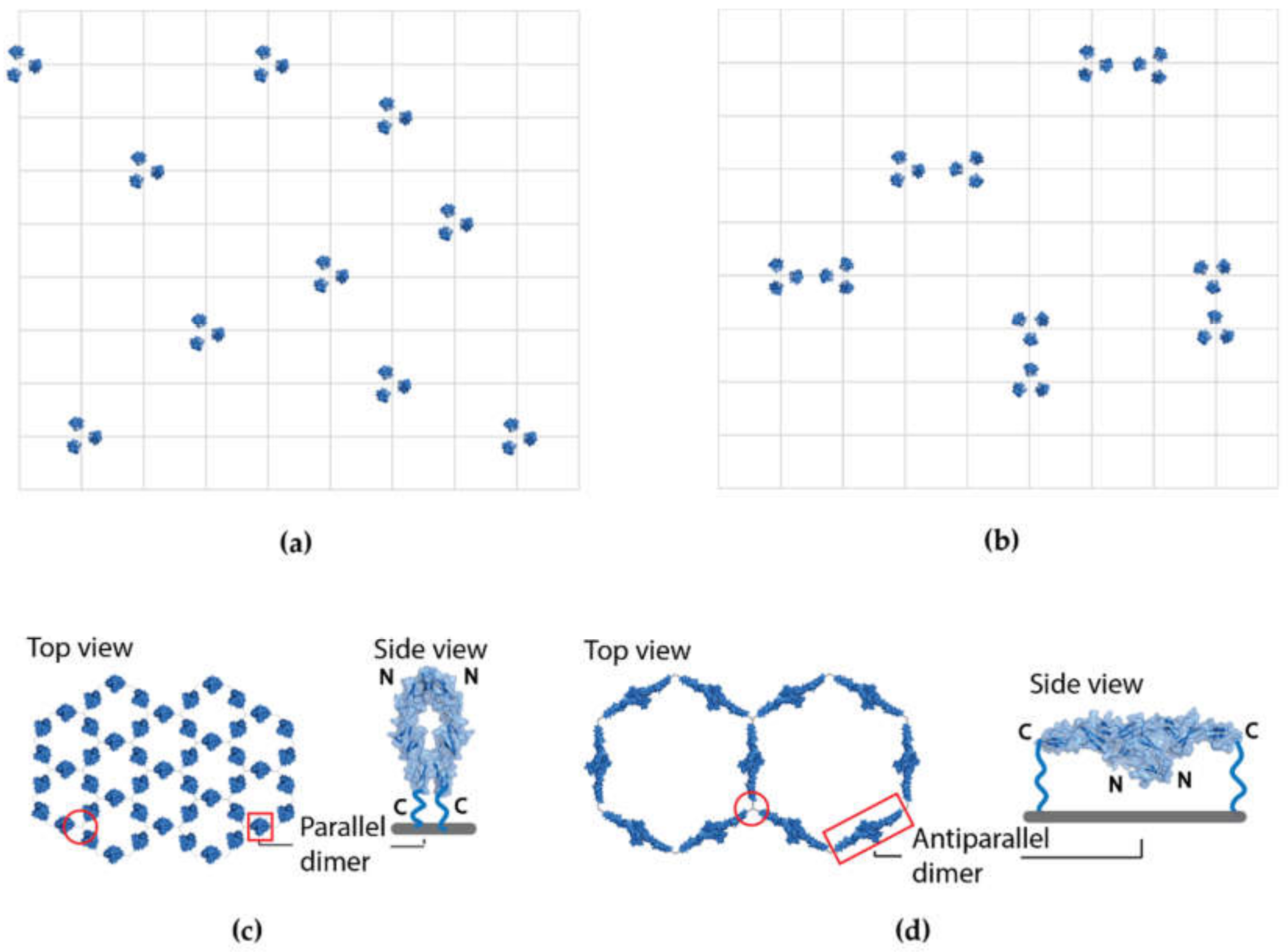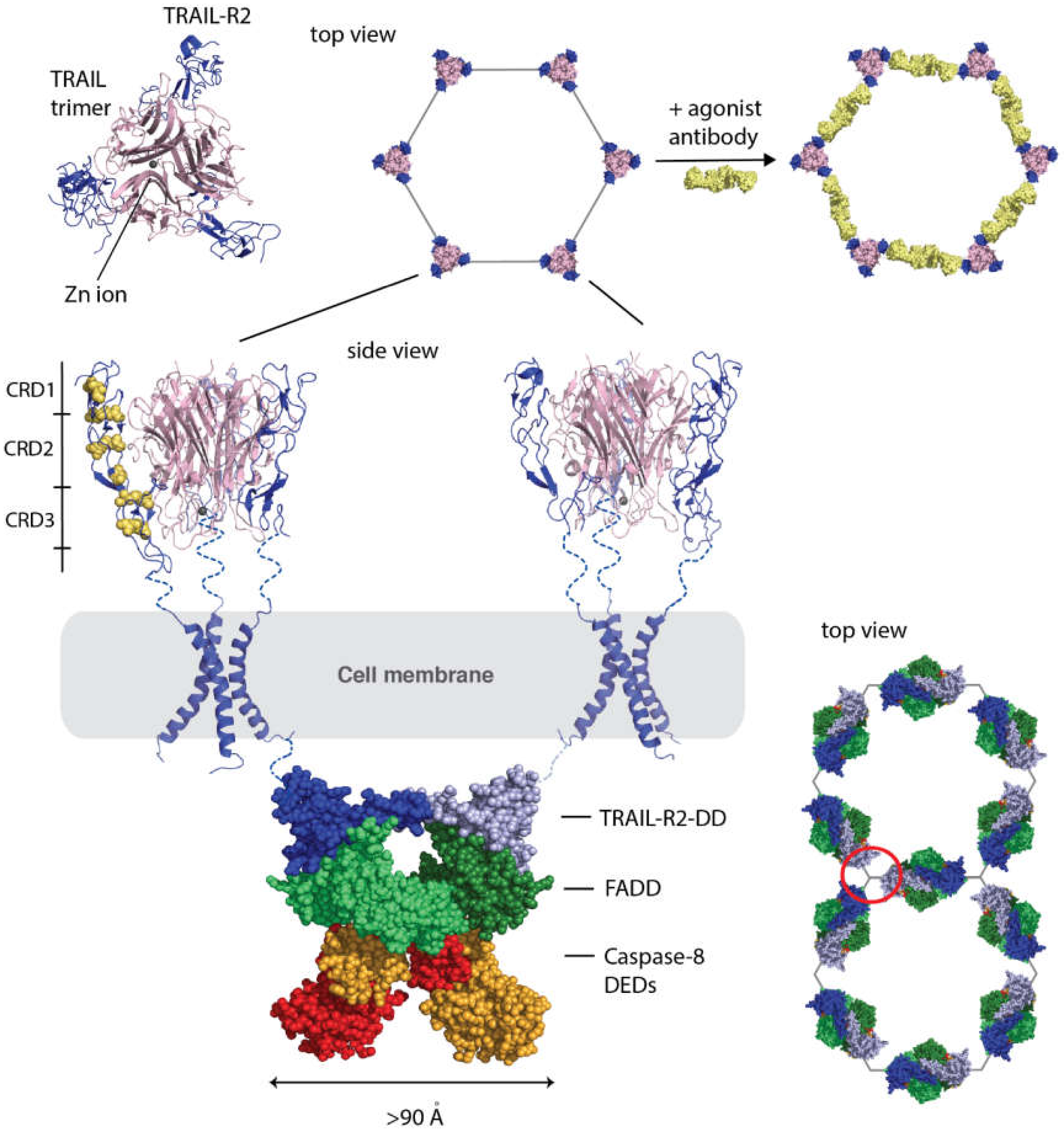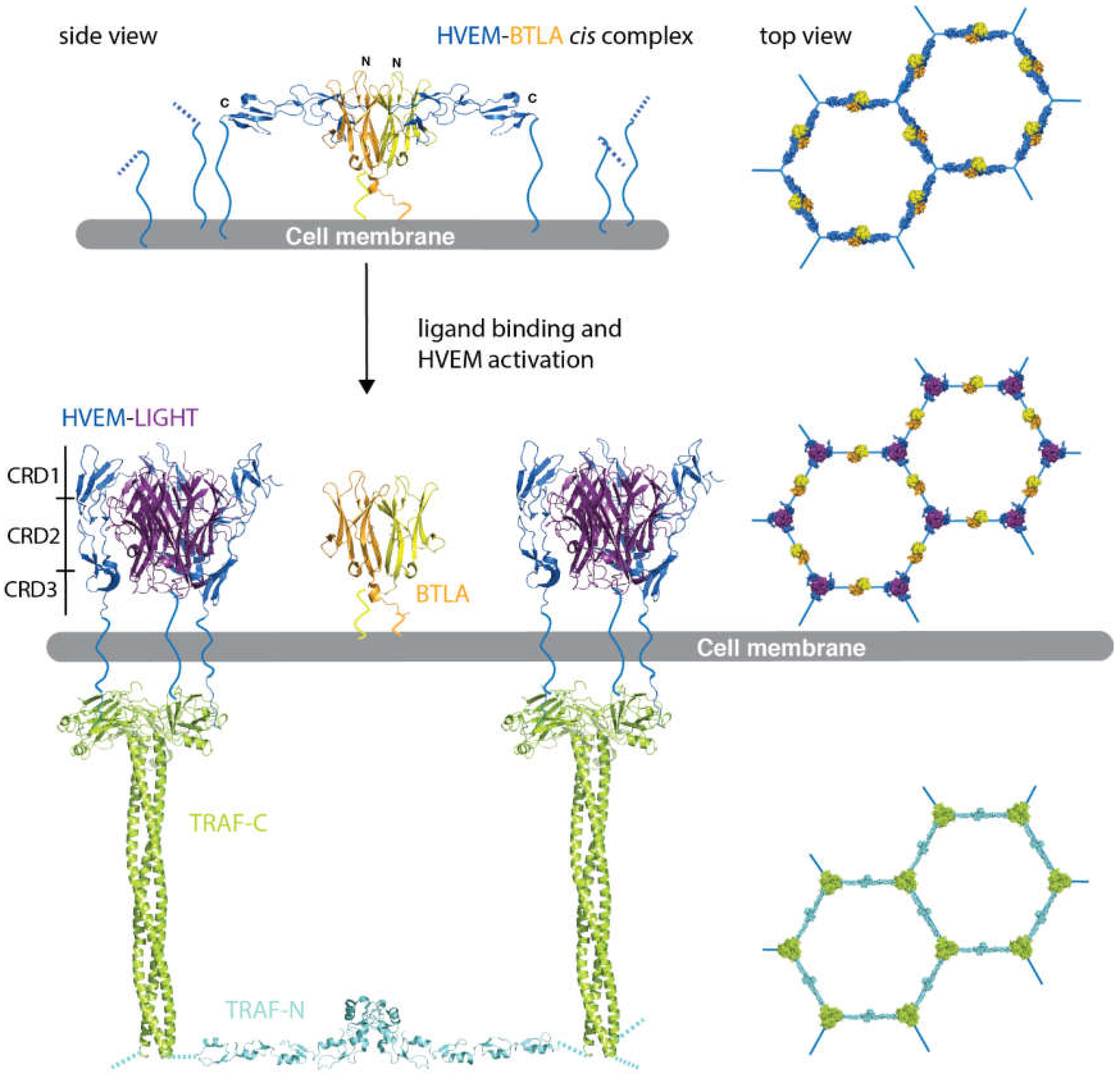On the TRAIL of Better Therapies: Understanding TNFRSF Structure-Function
Abstract
1. Introduction
2. Receptors and Ligands Need to Cluster in a Highly Ordered Manner on the Cell Surface for Efficient Signaling
3. TRAIL and Its Receptors
4. TRAIL Receptor Downstream Signaling: DISC Assembly and Caspase Interactions
5. TNFRSF Antiparallel Dimer Stabilization by Antibodies Effectively Block Ligand Binding
6. Regulating Receptor Function via Antiparallel Complex Formation
7. Conclusions
Author Contributions
Funding
Conflicts of Interest
References
- Pitti, R.M.; Marsters, S.A.; Ruppert, S.; Donahue, C.J.; Moore, A.; Ashkenazi, A. Induction of Apoptosis by Apo-2 Ligand, a New Member of the Tumor Necrosis Factor Cytokine Family. J. Biol. Chem. 1996, 271, 12687–12690. [Google Scholar] [CrossRef] [PubMed]
- Von Karstedt, S.; Montinaro, A.; Walczak, H. Exploring the TRAILs less travelled: TRAIL in cancer biology and therapy. Nat. Rev. Cancer 2017, 17, 352–366. [Google Scholar] [CrossRef] [PubMed]
- Dubuisson, A.; Micheau, O. Antibodies and Derivatives Targeting DR4 and DR5 for Cancer Therapy. Antibodies 2017, 6, 16. [Google Scholar] [CrossRef] [PubMed]
- Wajant. Molecular Mode of Action of TRAIL Receptor Agonists—Common Principles and their Translational Exploitation. Cancers 2019, 11, 954. [Google Scholar] [CrossRef]
- Sag, D.; Ayyildiz, Z.O.; Gunalp, S.; Wingender, G. The Role of TRAIL/DRs in the Modulation of Immune Cells and Responses. Cancers 2019, 11, 1469. [Google Scholar] [CrossRef] [PubMed]
- Naval, J.; De Miguel, D.; Gallego-Lleyda, A.; Anel, A.; Martinez-Lostao, L. Importance of TRAIL Molecular Anatomy in Receptor Oligomerization and Signaling. Implications for Cancer Therapy. Cancers 2019, 11, 444. [Google Scholar] [CrossRef]
- Rossin, A.; Miloro, G.; Hueber, A.-O. TRAIL and FasL Functions in Cancer and Autoimmune Diseases: Towards an Increasing Complexity. Cancers 2019, 11, 639. [Google Scholar] [CrossRef]
- Kretz, A.L.; Trauzold, A.; Hillenbrand, A.; Knippschild, U.; Henne-Bruns, D.; von Karstedt, S.; Lemke, J. TRAILblazing Strategies for Cancer Treatment. Cancers 2019, 11, 456. [Google Scholar] [CrossRef]
- Eck, M.J.; Sprang, S.R. The structure of tumor necrosis factor-alpha at 2.6 A resolution. Implications for receptor binding. J. Biol. Chem. 1989, 264, 17595–17605. [Google Scholar] [CrossRef] [PubMed]
- Hymowitz, S.G.; Christinger, H.W.; Fuh, G.; Ultsch, M.; O’Connell, M.; Kelley, R.F.; Ashkenazi, A.; de Vos, A.M. Triggering cell death: The crystal structure of Apo2L/TRAIL in a complex with death receptor 5. Mol. Cell 1999, 4, 563–571. [Google Scholar] [CrossRef]
- Smith, C.A.; Farrah, T.; Goodwin, R.G. The TNF receptor superfamily of cellular and viral proteins: Activation, costimulation, and death. Cell 1994, 76, 959–962. [Google Scholar] [CrossRef]
- Locksley, R.M.; Killeen, N.; Lenardo, M.J. The TNF and TNF receptor superfamilies: Integrating mammalian biology. Cell 2001, 104, 487–501. [Google Scholar] [CrossRef]
- Graves, J.D.; Kordich, J.J.; Huang, T.H.; Piasecki, J.; Bush, T.L.; Sullivan, T.; Foltz, I.N.; Chang, W.; Douangpanya, H.; Dang, T.; et al. Apo2L/TRAIL and the death receptor 5 agonist antibody AMG 655 cooperate to promote receptor clustering and antitumor activity. Cancer Cell 2014, 26, 177–189. [Google Scholar] [CrossRef] [PubMed]
- Vanamee, E.S.; Faustman, D.L. Structural principles of tumor necrosis factor superfamily signaling. Sci. Signal. 2018, 11. [Google Scholar] [CrossRef]
- Bongioanni, P.; Mosti, S.; Moscato, G.; Lombardo, F.; Manildo, C.; Meucci, G. Decreases in T-Cell Tumor Necrosis Factor α Binding with Interferon Beta Treatment in Patients with Multiple Sclerosis. Arch. Neurol. 1999, 56, 71. [Google Scholar] [CrossRef]
- Shalaby, M.R.; Palladino, M.A., Jr.; Hirabayashi, S.E.; Eessalu, T.E.; Lewis, G.D.; Shepard, H.M.; Aggarwal, B.B. Receptor Binding and Activation of Polymorphonuclear Neutrophils by Tumor Necrosis Factor-Alpha. J. Leukoc. Biol. 1987, 41, 196–204. [Google Scholar] [CrossRef]
- PyMOL. The PyMOL Molecular Graphics System; Version 2.3; Schrödinger, LLC: New York, NY, USA, 2020. [Google Scholar]
- Naismith, J.H.; Devine, T.Q.; Brandhuber, B.J.; Sprang, S.R. Crystallographic evidence for dimerization of unliganded tumor necrosis factor receptor. J. Biol. Chem. 1995, 270, 13303–13307. [Google Scholar] [CrossRef]
- Smulski, C.R.; Beyrath, J.; Decossas, M.; Chekkat, N.; Wolff, P.; Estieu-Gionnet, K.; Guichard, G.; Speiser, D.; Schneider, P.; Fournel, S. Cysteine-rich Domain 1 of CD40 Mediates Receptor Self-assembly. J. Biol. Chem. 2013, 288, 10914–10922. [Google Scholar] [CrossRef]
- Chan, F.K.-M. Three is better than one: Pre-ligand receptor assembly in the regulation of TNF receptor signaling. Cytokine 2007, 37, 101–107. [Google Scholar] [CrossRef]
- Chan, F.K.-M.; Chun, H.J.; Zheng, L.; Siegel, R.M.; Bui, K.L.; Lenardo, M.J. A Domain in TNF Receptors That Mediates Ligand-Independent Receptor Assembly and Signaling. Science 2000, 288, 2351–2354. [Google Scholar] [CrossRef]
- Deng, G.-M.; Zheng, L.; Ka-Ming Chan, F.; Lenardo, M. Amelioration of inflammatory arthritis by targeting the pre-ligand assembly domain of tumor necrosis factor receptors. Nat. Med. 2005, 11, 1066–1072. [Google Scholar] [CrossRef] [PubMed]
- Pan, G.; O’Rourke, K.; Chinnaiyan, A.M.; Gentz, R.; Ebner, R.; Ni, J.; Dixit, V.M. The receptor for the cytotoxic ligand TRAIL. Science 1997, 276, 111–113. [Google Scholar] [CrossRef]
- Chaudhary, P.M.; Eby, M.; Jasmin, A.; Bookwalter, A.; Murray, J.; Hood, L. Death receptor 5, a new member of the TNFR family, and DR4 induce FADD-dependent apoptosis and activate the NF-kappaB pathway. Immunity 1997, 7, 821–830. [Google Scholar] [CrossRef]
- Emery, J.G.; McDonnell, P.; Burke, M.B.; Deen, K.C.; Lyn, S.; Silverman, C.; Dul, E.; Appelbaum, E.R.; Eichman, C.; DiPrinzio, R.; et al. Osteoprotegerin is a receptor for the cytotoxic ligand TRAIL. J. Biol. Chem. 1998, 273, 14363–14367. [Google Scholar] [CrossRef] [PubMed]
- Marsters, S.A.; Sheridan, J.P.; Pitti, R.M.; Huang, A.; Skubatch, M.; Baldwin, D.; Yuan, J.; Gurney, A.; Goddard, A.D.; Godowski, P.; et al. A novel receptor for Apo2L/TRAIL contains a truncated death domain. Curr. Biol. 1997, 7, 1003–1006. [Google Scholar] [CrossRef]
- Bodmer, J.L.; Meier, P.; Tschopp, J.; Schneider, P. Cysteine 230 is essential for the structure and activity of the cytotoxic ligand TRAIL. J. Biol. Chem. 2000, 275, 20632–20637. [Google Scholar] [CrossRef]
- Kelley, S.K.; Harris, L.A.; Xie, D.; Deforge, L.; Totpal, K.; Bussiere, J.; Fox, J.A. Preclinical studies to predict the disposition of Apo2L/tumor necrosis factor-related apoptosis-inducing ligand in humans: Characterization of in vivo efficacy, pharmacokinetics, and safety. J. Pharmacol. Exp. Ther. 2001, 299, 31–38. [Google Scholar] [PubMed]
- De Miguel, D.; Lemke, J.; Anel, A.; Walczak, H.; Martinez-Lostao, L. Onto better TRAILs for cancer treatment. Cell Death Differ. 2016, 23, 733–747. [Google Scholar] [CrossRef]
- Scott, F.L.; Stec, B.; Pop, C.; Dobaczewska, M.K.; Lee, J.J.; Monosov, E.; Robinson, H.; Salvesen, G.S.; Schwarzenbacher, R.; Riedl, S.J. The Fas-FADD death domain complex structure unravels signalling by receptor clustering. Nature 2009, 457, 1019–1022. [Google Scholar] [CrossRef]
- Shen, C.; Pei, J.; Guo, X.; Zhou, L.; Li, Q.; Quan, J. Structural basis for dimerization of the death effector domain of the F122A mutant of Caspase-8. Sci. Rep. 2018, 8, 16723. [Google Scholar] [CrossRef]
- Kelley, L.A.; Mezulis, S.; Yates, C.M.; Wass, M.N.; Sternberg, M.J.E. The Phyre2 web portal for protein modeling, prediction and analysis. Nat. Protoc. 2015, 10, 845–858. [Google Scholar] [CrossRef] [PubMed]
- Carrington, P.E.; Sandu, C.; Wei, Y.; Hill, J.M.; Morisawa, G.; Huang, T.; Gavathiotis, E.; Wei, Y.; Werner, M.H. The Structure of FADD and its Mode of Interaction with Procaspase-8. Mol. Cell 2006, 22, 599–610. [Google Scholar] [CrossRef] [PubMed]
- Tuthill, M.H.; Montinaro, A.; Zinngrebe, J.; Prieske, K.; Draber, P.; Prieske, S.; Newsom-Davis, T.; von Karstedt, S.; Graves, J.; Walczak, H. TRAIL-R2-specific antibodies and recombinant TRAIL can synergise to kill cancer cells. Oncogene 2015, 34, 2138–2144. [Google Scholar] [CrossRef] [PubMed]
- Nemčovičová, I.; Benedict, C.A.; Zajonc, D.M. Structure of Human Cytomegalovirus UL141 Binding to TRAIL-R2 Reveals Novel, Non-canonical Death Receptor Interactions. PLoS Pathog. 2013, 9, e1003224. [Google Scholar] [CrossRef]
- Pan, L.; Fu, T.M.; Zhao, W.; Zhao, L.; Chen, W.; Qiu, C.; Liu, W.; Liu, Z.; Piai, A.; Fu, Q.; et al. Higher-Order Clustering of the Transmembrane Anchor of DR5 Drives Signaling. Cell 2019, 176, 1477–1489.e14. [Google Scholar] [CrossRef]
- Chen, X.; Baumel, M.; Mannel, D.N.; Howard, O.M.; Oppenheim, J.J. Interaction of TNF with TNF receptor type 2 promotes expansion and function of mouse CD4+CD25+ T regulatory cells. J. Immunol. 2007, 179, 154–161. [Google Scholar] [CrossRef]
- Torrey, H.; Butterworth, J.; Mera, T.; Okubo, Y.; Wang, L.; Baum, D.; Defusco, A.; Plager, S.; Warden, S.; Huang, D.; et al. Targeting TNFR2 with antagonistic antibodies inhibits proliferation of ovarian cancer cells and tumor-associated Tregs. Sci. Signal. 2017, 10. [Google Scholar] [CrossRef]
- Vanamee, E.S.; Faustman, D.L. TNFR2: A Novel Target for Cancer Immunotherapy. Trends Mol. Med. 2017, 23, 1037–1046. [Google Scholar] [CrossRef]
- Torrey, H.; Khodadoust, M.; Tran, L.; Baum, D.; Defusco, A.; Kim, Y.H.; Faustman, D.L. Targeted killing of TNFR2-expressing tumor cells and Tregs by TNFR2 antagonistic antibodies in advanced Sézary syndrome. Leukemia 2019, 33, 1206–1218. [Google Scholar] [CrossRef]
- Argiriadi, M.A.; Benatuil, L.; Dubrovska, I.; Egan, D.A.; Gao, L.; Greischar, A.; Hardman, J.; Harlan, J.; Iyer, R.B.; Judge, R.A.; et al. CD40/anti-CD40 antibody complexes which illustrate agonist and antagonist structural switches. BMC Mol. Cell Biol. 2019, 20. [Google Scholar] [CrossRef]
- Kaye, J. CD160 and BTLA: LIGHTs out for CD4+ T cells. Nat. Immunol. 2008, 9, 122–124. [Google Scholar] [CrossRef] [PubMed]
- De Trez, C.; Schneider, K.; Potter, K.; Droin, N.; Fulton, J.; Norris, P.S.; Ha, S.W.; Fu, Y.X.; Murphy, T.; Murphy, K.M.; et al. The inhibitory HVEM-BTLA pathway counter regulates lymphotoxin receptor signaling to achieve homeostasis of dendritic cells. J. Immunol. 2008, 180, 238–248. [Google Scholar] [CrossRef]
- Steinberg, M.W.; Turovskaya, O.; Shaikh, R.B.; Kim, G.; McCole, D.F.; Pfeffer, K.; Murphy, K.M.; Ware, C.F.; Kronenberg, M. A crucial role for HVEM and BTLA in preventing intestinal inflammation. J. Exp. Med. 2008, 205, 1463–1476. [Google Scholar] [CrossRef] [PubMed]
- Montgomery, R.I.; Warner, M.S.; Lum, B.J.; Spear, P.G. Herpes simplex virus-1 entry into cells mediated by a novel member of the TNF/NGF receptor family. Cell 1996, 87, 427–436. [Google Scholar] [CrossRef]
- Watanabe, N.; Gavrieli, M.; Sedy, J.R.; Yang, J.; Fallarino, F.; Loftin, S.K.; Hurchla, M.A.; Zimmerman, N.; Sim, J.; Zang, X.; et al. BTLA is a lymphocyte inhibitory receptor with similarities to CTLA-4 and PD-1. Nat. Immunol. 2003, 4, 670–679. [Google Scholar] [CrossRef] [PubMed]
- Compaan, D.M.; Gonzalez, L.C.; Tom, I.; Loyet, K.M.; Eaton, D.; Hymowitz, S.G. Attenuating Lymphocyte Activity: The Crystal Structure of the BTLA-HVEM Complex. J. Biol. Chem. 2005, 280, 39553–39561. [Google Scholar] [CrossRef] [PubMed]
- Cheung, T.C.; Steinberg, M.W.; Oborne, L.M.; Macauley, M.G.; Fukuyama, S.; Sanjo, H.; D’Souza, C.; Norris, P.S.; Pfeffer, K.; Murphy, K.M.; et al. Unconventional ligand activation of herpesvirus entry mediator signals cell survival. Proc. Natl. Acad. Sci. USA 2009, 106, 6244–6249. [Google Scholar] [CrossRef]
- Cheung, T.C.; Ware, C.F. The canonical and unconventional ligands of the herpesvirus entry mediator. Adv. Exp. Med. Biol. 2011, 691, 353–362. [Google Scholar] [CrossRef]
- Liu, W.; Garrett, S.C.; Fedorov, E.V.; Ramagopal, U.A.; Garforth, S.J.; Bonanno, J.B.; Almo, S.C. Structural Basis of CD160:HVEM Recognition. Structure 2019, 27, 1286–1295.e4. [Google Scholar] [CrossRef]
- Anumanthan, A.; Bensussan, A.; Boumsell, L.; Christ, A.D.; Blumberg, R.S.; Voss, S.D.; Patel, A.T.; Robertson, M.J.; Nadler, L.M.; Freeman, G.J. Cloning of BY55, a novel Ig superfamily member expressed on NK cells, CTL, and intestinal intraepithelial lymphocytes. J. Immunol. 1998, 161, 2780–2790. [Google Scholar] [PubMed]
- Maiza, H.; Leca, G.; Mansur, I.G.; Schiavon, V.; Boumsell, L.; Bensussan, A. A novel 80-kD cell surface structure identifies human circulating lymphocytes with natural killer activity. J. Exp. Med. 1993, 178, 1121–1126. [Google Scholar] [CrossRef] [PubMed]
- Kojima, R.; Kajikawa, M.; Shiroishi, M.; Kuroki, K.; Maenaka, K. Molecular Basis for Herpesvirus entry Mediator Recognition by the Human Immune Inhibitory Receptor CD160 and its Relationship to the Cosignaling Molecules BTLA and LIGHT. J. Mol. Biol. 2011, 413, 762–772. [Google Scholar] [CrossRef] [PubMed]



| TNFRSF Receptor (TNFRSF#, Other Names) | Number of CRD‡ | Intracellular Binding Partner | TNFSF Ligand (TNFSF#, Other Names) |
|---|---|---|---|
| Death receptors | |||
| TNFR1 (1a, CD120a) | 4 | TRADD, FADD, RIP | TNF (2, TNF-α), LTα (1, TNF-β), LTβ (3) |
| Fas (6, CD95) | 3 | FADD | FasL (6, CD178) |
| TRAILR1 (10A, DR4, CD261) | 3¶ | FADD, TRADD, RIP | TRAIL/Apo2L (10, CD253) |
| TRAILR2 (10B, DR5, CD262) | 3¶ | FADD, TRADD, RIP | TRAIL/Apo2L (10, CD253) |
| NGFR (16, p75NTR, CD271) | 4 | NADE | NGF (not a TNFSF member) |
| DR3 (25 or 12, TRAMP) | 4¶ | TRADD, FADD | TL1A (15, VEGI), TWEAK (12) |
| DR6 (21, CD358) | 4 | TRADD, RIP | N-APP (not a TNFSF member) |
| EDAR | 3¶ | EDARADD | EDA-A1 |
| Receptors with TRAF-interacting motif | |||
| TNFR2 (1b, CD120b) | 4 | TRAF1-3 | TNF (2, TNF-α), LTα (1, TNF-β) |
| LTβR (3) | 4 | TRAF2-4, TRAF5 | LTα (1, TNF-β), LTβ (3) as LTαβ2, LTα2β |
| OX40 (4, CD134) | 4¶ | TRAF1-3, TRAF5, TRAF6 | OX40L (4, CD252) |
| CD40 (5) | 4 | TRAF1-3, TRAF5, TRAF6 | CD40L (5, CD154) |
| CD27 (7) | 3 | TRAF2, TRAF3, TRAF5 | CD27L (7, CD70) |
| CD30 (8) | 6 | TRAF1-3, TRAF5 | CD30L (8, CD153) |
| 4-1BB (9, CD137) | 4 | TRAF1-3 | 4-1BBL (9, CD137L) |
| RANK (11A, CD265) | 4 | TRAF1-3, TRAF5, TRAF6 | RANKL (11, TRANCE, CD254) |
| Fn14 (12A, TWEAKR; CD266) | 1 | TRAF2, TRAF6 | TWEAK (12) |
| TACI (13B, CD267) | 2 | TRAF2-3, TRAF5, TRAF6 | APRIL (13, CD256) |
| BAFFR (13C, BR3, CD268) | 1 | TRAF2, TRAF3, TRAF6 | BAFF (13B/20, BLys, THANK, CD257) |
| HVEM (14, CD270) | 3 | TRAF1-3, TRAF5 | LIGHT (14, CD258), LT-α (1, TNF-β) |
| BCMA (17, CD269) | 1 | TRAF1-3, TRAF5, TRAF6 | APRIL (13, CD256), BAFF (13B/20, BLys, THANK, CD257) |
| GITR (18, AITR, CD357) | 3 | TRAF1-3 | GITRL (18, AITRL, TL6) |
| TROY (19, TAJ) | 3¶ | TRAF1-3, TRAF5 | ? |
| RELT (19L) | 1 | TRAF1 | Not known |
| XEDAR (27) | 3¶ | TRAF1, TRAF3, TRAF6 | EDA-A2 |
| Decoy receptors | n/a | ||
| TRAILR3 (10C, DcR1, CD263) | 3¶ | TRAIL/Apo2L (10, CD253) | |
| TRAILR4 (10D, DcR2, CD264) | 3¶ | TRAIL/Apo2L (10, CD253) | |
| OPG (11B) | 4 | TRAIL/Apo2L (10, CD253), RANKL (11, TRANCE, CD254) | |
| DcR3 (6B) | 4 | FasL (6), TL1A (15, VEGI), LIGHT (14, CD258) |
© 2020 by the authors. Licensee MDPI, Basel, Switzerland. This article is an open access article distributed under the terms and conditions of the Creative Commons Attribution (CC BY) license (http://creativecommons.org/licenses/by/4.0/).
Share and Cite
Vanamee, É.S.; Faustman, D.L. On the TRAIL of Better Therapies: Understanding TNFRSF Structure-Function. Cells 2020, 9, 764. https://doi.org/10.3390/cells9030764
Vanamee ÉS, Faustman DL. On the TRAIL of Better Therapies: Understanding TNFRSF Structure-Function. Cells. 2020; 9(3):764. https://doi.org/10.3390/cells9030764
Chicago/Turabian StyleVanamee, Éva S., and Denise L. Faustman. 2020. "On the TRAIL of Better Therapies: Understanding TNFRSF Structure-Function" Cells 9, no. 3: 764. https://doi.org/10.3390/cells9030764
APA StyleVanamee, É. S., & Faustman, D. L. (2020). On the TRAIL of Better Therapies: Understanding TNFRSF Structure-Function. Cells, 9(3), 764. https://doi.org/10.3390/cells9030764






